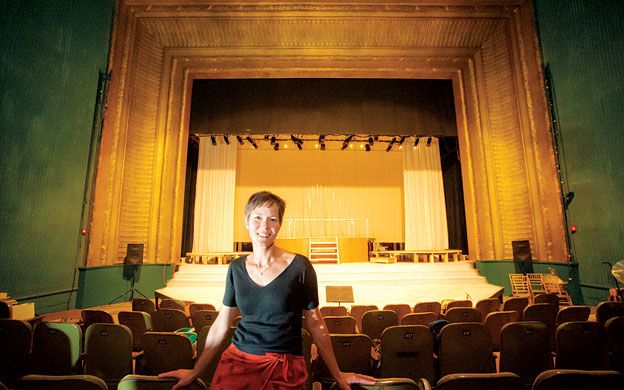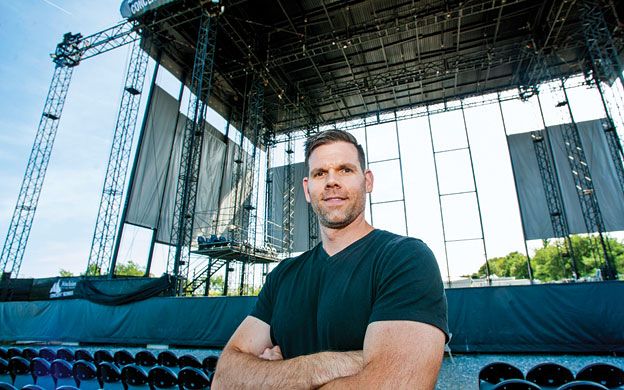Now trending: Bangor as an entertainment destination
Every August for nine years now, on a three-day weekend, the Bangor waterfront along the Penobscot River comes alive with music and dance from around the nation and the world, performed simultaneously from many stages, thronged by thousands of smiling, foot-tapping, photo-snapping listeners.
This is the American Folk Festival, a free event hosted by the City of Bangor and modeled on the traveling National Folk Festival, which was in town 2002-2004.
The festival is just one of a tapestry of cultural events and venues that is today putting Bangor on the map as an entertainment destination.
The new designation comes courtesy of both long-time and newcomer entertainment providers, as well as the city, which has a revitalization project in the works aimed at enhancing both the provider and consumer experience, not only in entertainment but in all walks of life.
Bangor is a great place to shop for the variety of goods and services only a city can provide. It's known by travelers as a gateway to other destinations, such as Acadia National Park and Baxter State Park. And the city already has a long tradition of cultural offerings. It's not unusual for people to travel a couple of hours to attend a play or concert, preceded by dinner at one of the downtown restaurants.
“I think there's always been a strong foundation in cultural institutions — Robinson Ballet, Bangor Ballet, Bangor Symphony,” to name just a few, says Caitlin Brooke, Bangor's business development specialist and downtown coordinator.
Now, says Brooke, people are realizing they can do more. “People with a lot of grit and ability to get things done are demonstrating, 'Yes, we're here,'” she says.
Brooke noted the creative spirit runs the gamut from large to small, established to new — theater troupes to art museums, artist talks to ballet, major music festivals to village-square events. Entertainment consumers increasingly come from beyond the region, folks who otherwise might not travel to Bangor, says the city's community and economic development officer, Jason Bird. And they spend money.
“When they go to a performance at the Cross Insurance Center, or play at the casino, they're coming to Bangor for more than just that,” Bird says. “People typically look for a place to shop, eat and stay, and that spurs further economic development.”
In turn, the city gains a certain “cool” imprint that also spurs development, says John Porter, president of the Bangor Region Chamber of Commerce.
“Yes, Bangor needs to have great infrastructure, good policies that help businesses grow and programming and resources for entrepreneurs,” Porter says. “But Bangor also needs to be a cool place. People don't want to start a business in a place that's not cool.”
A nearly lifelong resident here, Daniel Williams, has witnessed the evolution of the region as an entertainment destination. He's the executive director of the University of Maine's Collins Center for the Arts, its theater, comedy, music, dance, opera simulcasts, and educational offerings attracting just under 45,000 people per season from eastern, central and northern Maine, the Canadian Maritimes, and sometimes other New England states.
“I remember when the Maine Center for the Arts opened its doors,” Williams says, referring to CCA under its original name in 1986. “It changed our community overnight. I believe the MCA was the start of a cultural experiment that has been wildly successful. Ten or 15 years ago, we heard a lot of talk about the creative economy. I think we are seeing that concept in full swing in greater Bangor.” After MCA, the next high-water mark was the National Folk Festival, Williams says: “That showed we had the capacity for large-scale events.”
Heather McCarthy, executive director of the American Folk Festival, says the region was eager from the start for diverse music. Free admission made it irresistible. With 90,000 visitors in 2013, they remain eager. The $900,000 budget is met by corporate sponsors, gifts, grants and a “bucket brigade” roaming the grounds for donations. And the folk festival's local backers are happy to be part of a larger scene, McCarthy says. “Today, when people outside of Bangor say, 'What's going on?' we can reel off all kinds of events — the concerts, the festivals, the theater.”
That cooperative spirit is echoed by others. For Mary Budd, managing director of the Penobscot Theatre Co., it's about synergy. A long-time venue incorporated in 1983, PTC, the only year-round, professional theater in northern Maine, had 2013 attendance of more than 27,000 coming from throughout Maine and eastern Canada. It also offers educational programs. Still, there was a fear that more concerts and events in surrounding Bangor could potentially cut into the theater's audience.
“I think the big question for nonprofits like us, with the advent of new venues, was, 'How will that impact us? Will it take our audience in a different direction?'” Budd says. “Happily, we've seen very much the opposite. Those organizations have fueled a hunger for live entertainment, and that has benefited all of us.”
Many credit the Waterfront Concert Series, which started offering large-scale concerts in 2010. Founder Alex Gray, an Old Town native and nightclub entrepreneur who also manages entertainment facilities in Portland and Lewiston, initially negotiated with the city for a one-year deal.
“This series is more successful than we anticipated,” he says. “I don't think anyone could have imagined it would be what it is today.” With well-developed municipal services, and a 58-acre park suitable for construction of an open-air amphitheater each summer, Gray says Bangor was ideally suited for outdoor events featuring nationally known musicians drawing tens of thousands.
From 2010 to 2013, the series drew more than 300,000 people overall, its market area and local economic benefits continually expanding, says an economic impact study conducted by University of Maine economics professor Todd Gabe. Money going into local-service activity — security, catering, and technical set-up, plus accommodations, food, beverages and retail purchases — totaled $3 million in 2010 and $10.7 million by 2013. Including indirect spending, encompassing area restaurants and attractions, the total economic benefit more than tripled over three years, from $4.9 million in 2010 to $17.5 million in 2013.
“They helped pave the way by bringing in large acts,” says Tiffany Sun, marketing director of the city-owned Cross Insurance Center, which opened in late 2013. “So when people think of Bangor, they think of entertainment.”
And the party keeps growing. There are indigenous arts at CCA's Hudson Museum, fine arts at the University of Maine's Museum of Arts and children's activities at the Maine Discovery Museum. Comedy and theater are offered at Husson University's Gracie Theatre. There's also the Hollywood Casino and Raceway. Then there's the lively local artist scene — the Bangor Band outdoor concerts, the Cool Sounds Summer Concert Series, the pub bands and outdoor movie screenings.
Still, the waterfront has had hiccups.
Earlier this summer, KahBang, the six-year-old festival of music, film and art, abruptly moved to Portland just weeks before the event. Later, it dropped its music lineup, citing weak ticket sales.
Porter of the chamber says the KahBang experience offers a lesson for the future.
“We need to check in with each other to make sure everyone is doing OK,” Porter says. “If they needed financial expertise, sponsors, conversations with the city — people could have helped. I think there was a failure on our part not to recognize that one of the tribe was having some trouble.”
Going forward, the city is continuing to invest in the waterfront. It already spent $12 million over the past decade to transform the waterfront from a defunct rail yard. Now, revitalization projects will provide attractive pedestrian links between the waterfront and downtown. Phase 1 is underway, a $1.5 million investment in West Market Square, considered the heart of downtown, anchoring a section of restaurants and shops, and providing a street-side venue for small events. Completion is expected in September. Future development will focus on the streetscape from West Market to Pickering Square and finishing the connection to the waterfront.
And the city plans to put more into marketing itself, both as a whole and as an entertainment destination.
“We've relied on the Convention and Visitors Bureau, the chamber and individual events to tell our story,” says Bird in the city's economic development office. “We want to add to that chorus and highlight the city even more. Our aim is to spur further economic development as more and more people become aware of the city's transformation.”
Correction: A previous version of this story incorrectly stated the names of Husson University and its theater, Gracie Theatre.
Read more
Renovate the Alamo: Struggling small-town theater fortified by community
Innovation, Maine style: A creativity hub hopes to keep good ideas in-state
Renovate the Alamo: Struggling small-town theater fortified by community
Innovation, Maine style: A creativity hub hopes to keep good ideas in-state












Comments